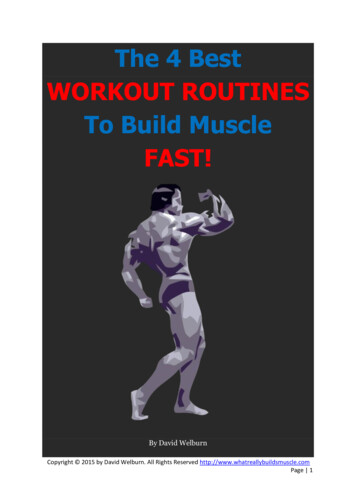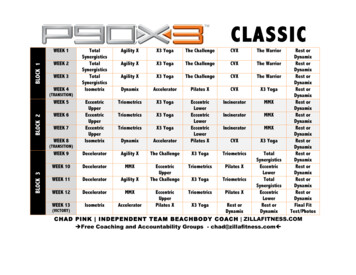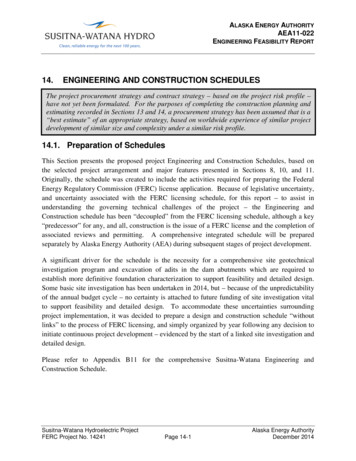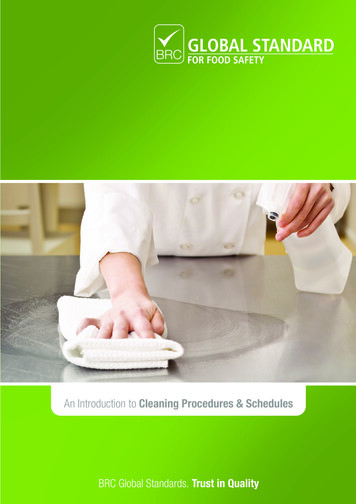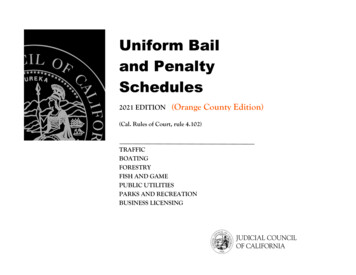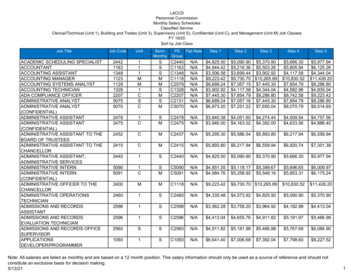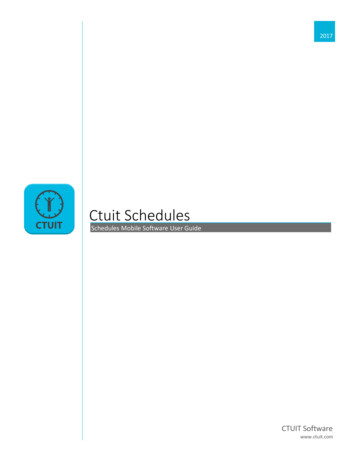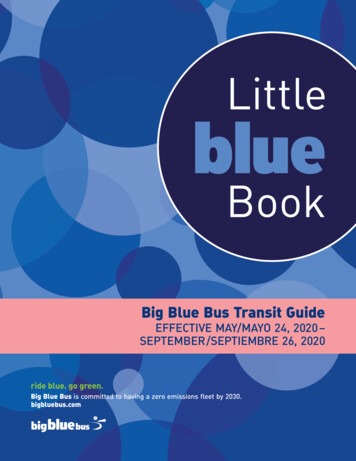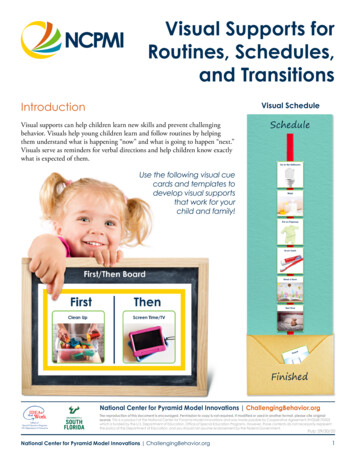
Transcription
Visual Supports forRoutines, Schedules,and TransitionsIntroductionVisual ScheduleVisual supports can help children learn new skills and prevent challengingbehavior. Visuals help young children learn and follow routines by helpingthem understand what is happening “now” and what is going to happen “next.”Visuals serve as reminders for verbal directions and help children know exactlywhat is expected of them.Use the following visual cuecards and templates todevelop visual supportsthat work for yourchild and family!National Center for Pyramid Model Innovations ChallengingBehavior.orgThe reproduction of this document is encouraged. Permission to copy is not required. If modified or used in another format, please cite originalsource. This is a product of the National Center for Pyramid Model Innovations and was made possible by Cooperative Agreement #H326B170003which is funded by the U.S. Department of Education, Office of Special Education Programs. However, those contents do not necessarily representthe policy of the Department of Education, and you should not assume endorsement by the Federal Government.Pub: 09/30/20National Center for Pyramid Model Innovations ChallengingBehavior.org1
Visual Supports for Routines, Schedules, and TransitionsVisual SchedulesUsing a visual schedule at home provides young children with predictability (i.e., they know what activity or routineis coming and when) and consistency (i.e., the schedule of activities or routines is the same). Visual schedules helpchildren know what their day will look like by letting them know when activities or routines will happen. Thesevisual cards will make this process easy!Making a Visual Schedule1. Identify when you need a visual schedule. A visual schedule might outline parts of a day, half-day, or anentire day. Pick the times of your day when your child might need extra support to engage in activities orcope with transitions.2. List the steps you want your child to follow. For example, for a bedtimeroutine, you might list: go to the bathroom wash put on pajamas brush teeth read a book bed timeTIP! Structure the day so that fun activities follow ones that are challenging.You might put cleaning up right before going outside or brushing teeth rightbefore reading books.3. Cut out the cards. Optional: Print cards on cardstock, attach to thickerpaper, laminate, or make cards sturdy by covering with clear tape or clearcontact paper.4. Select the visual cards for the schedule you want to create. Don’t see a visualyou need? It’s easy to make your own! See the page 4 for directions.5. Get creative! Use tape, Velcro, or magnets to post the visual cards in theorder your child will do them. Families find that posters, file folders, orhanging pocket charts work great for visual schedules.TIP! Schedules work best when children can see when they are done with anactivity. Here are some ideas: Create a pocket at the bottom or end of the display that represents“finished” or “all done.” Place visuals in envelope or pocket when finished. Make a schedule with visuals that can be removed. If your schedule is a book format, turn the page. Use a placeholder (like a clothespin or paper clip) that can move fromvisual to visual.6. Post the schedule. Place the schedule at the child’s eye level in a place where you go often (e.g., kitchen) topromote consistent use. Use the schedule as part of your daily routine!ChallengingBehavior.org National Center for Pyramid Model Innovations2
Visual Supports for Routines, Schedules, and TransitionsHow to Use Teach your child how to use the schedule by explaining and demonstrating how to use the pictures. Refer to the visual schedule throughout the day (e.g., “We just got home, let’s go check your schedule to seewhat is next.”). Talk about the schedule (e.g., “Look, you just got dressed. Now it is time for breakfast!”). Make it active! Teach the child to indicate what is complete. You can have your child flip the card over orremove it from the schedule and put in the “finished” pocket depending on how your schedule is set up. Celebrate! Be sure to celebrate your success and the child’s success. Acknowledge and provide positivefeedback to your child after activities or routines, especially ones that are not as fun (e.g., “You cleaned up!You must be feeling so proud!” or “Your teeth are so clean now. You are so healthy!”).First/Then BoardsFirst/Then boards can be used for a variety of reasons. Theycan be used to:FirstThenRead a BookPut on Pajamas Assist with transition from one activity to another.For example, “First clean up, then play outside.” Break routines into smaller steps. For example, “Go tothe bathroom and wash hands, then brush your teeth.” Encourage children to complete tasks they might notenjoy in order to do a more enjoyable task. For example,“First brush your teeth, then you can have your tablet.”Making a First/Then Board1. Cut out the cards. Optional: Print cards on cardstock,attach to thicker paper, laminate, or make cards sturdyby covering with clear tape or clear contact paper.FirstGo to the BathroomThenWash HandsBrush Teeth2. Select the visual cards that represent the activitiesyou need. Don’t see a visual you need? It’s easy to makeyour own! See page 4 for directions.3. Make the boards. Print the board templates providedon pages 5 and 6, or get creative and make your own! Use a file folder, large (4x6) index card, or apiece of cardboard. You want it large enough to hold several of the visuals. Divide board into two sections by making a vertical line to make a FIRST section and a THENsection. Label one section “First” and the other section “Then.”4. Attach cards. If you are able, use small pieces of Velcro on the back of the pictures.TIP! Velcro has a rough side and a soft side. Be sure you use the same side on all the pictures. Next, place astrip of opposite Velcro on both sides of the First/Then board.ChallengingBehavior.org National Center for Pyramid Model Innovations3
Visual Supports for Routines, Schedules, and TransitionsHow to Use Try it out! As you use the First/Then board with your child, place a preferred activity or item on the “then”side of the board. This will increase the likelihood that the child will complete the activities on the “first”side of the board. See the examples below:FirstBrush TeethBrush TeethThenRead a BookRead a bookFirstMealMealThenFirstIndoor PlayGet DressedIndoor playGet dressedThenOutdoor PlayOutdoor play Flip the picture over, as each activity is completed, to indicate that the activity is “finished.” If you place astrip of Velcro on the front of the picture card, you can flip it over and stick it to the board. Celebrate! Acknowledge and provide feedback to your child after they complete the “first” activity and aremoving to what is coming next (e.g., “You washed your hands and now we get to eat our yummy snack!What a big kid!” Or “You put on your pajamas and now we get to read a book together. Thanks for beingsuch a great bedtime helper!”).Making Your Own Visual CardsDon’t see a visual you wantor a visual that matches your activity?It’s easy to make your own!dnuroerapygyThPla1. Identify the steps in your routine that are missing visual cards.2. Using the blank cards provided on page 9, you can: draw a picture attach a photo cut out and attach a picture from a magazineTIP! In addition to the visuals that we have provided, you mightwant to add more specific visuals that can help your child. For example, if your child receives speechtherapy, take a picture of your child’s speech therapist and use it instead of the visual we have provided. Ifyour child rides a bus to school, take a picture of a bus that you can use with the visual for going to school.3. Label the visual. Write on the template or if using the electronic template, type in the name of the routine.For example, if you drew a picture of going for a walk, then label the picture, “go for a walk.”4. Cut out the new visual and it add to your visual schedule or first-then board.TIP! Remember, the more specific the visual is to your child and your daily routines, the more likely you willbe able to teach the steps and your child will follow the routine.ChallengingBehavior.org National Center for Pyramid Model Innovations4
Visual Supports for Routines, Schedules, and rg National Center for Pyramid Model Innovations5
FirstThenVisual Supports for Routines, Schedules, and TransitionsChallengingBehavior.org National Center for Pyramid Model Innovations6
Visual Supports for Routines, Schedules, and TransitionsWashGo to the BathroomBrush TeethWash HandsGet DressedPut on PajamasOutdoor PlayIndoor PlayLearningRead a BookScreen Time/TVSchool/ChildcareChallengingBehavior.org National Center for Pyramid Model Innovations7
Visual Supports for Routines, Schedules, and TransitionsStopAll Done5 More MinutesWaitMedicine/TreatmentTherapyMealSnackSit at TableLie DownRestBed TimeChallengingBehavior.org National Center for Pyramid Model Innovations8
Visual Supports for Routines, Schedules, and TransitionsClean UpChallengingBehavior.org National Center for Pyramid Model Innovations9
Sep 30, 2020 · First/Then Boards First/Then boards can be used for a variety of reasons. They can be used to: Assist with transition from one activity to another. For example, “First clean up, then play outside.” Break routines into smaller steps. For example, “G
